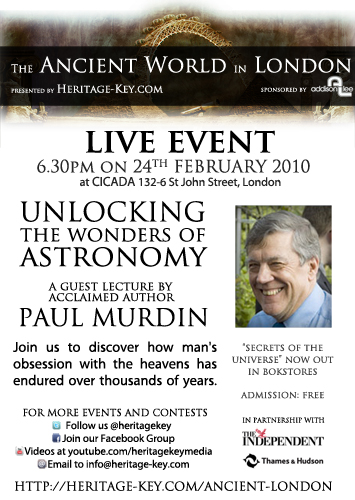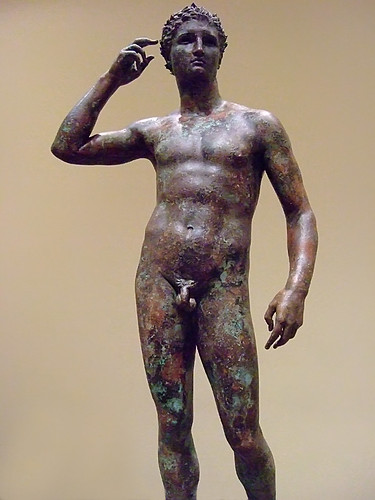A team of archaeologists has unearthed five chamber tombs in the Nemea Valley, just a few hours walk from the ancient city of Mycenae. The tombs date from ca. 1350 1200 BC, roughly the same time that Mycenae was thriving. The people buried in the tombs were likely not from the city itself, but rather from Tsoungiza, an agricultural settlement that lies next to it. The cemetery has been named Ayia Sotira. But despite a wealth of human remains, there have been no discoveries of elite burials. Are the archaeologists yet to discover the prize tombs, or could this be…
-
-
Ancient World Season with Bettany Hughes by Bettany Hughes Historian Bettany Hughes gives her personal take on the diverse cultures of the ancient world in this 2010 documentary series on More 4. The series begins with an examination of Alexandria, the city founded by Alexander the Great in 332 BC to become the world’s first global centre of culture. The programme explores Alexandria’s role as a powerhouse of science and learning, and focuses on the female mathematician, astronomer and philosopher Hypatia, the subject of the feature film Agora, starring Rachel Weisz. The series also offers a chance to catch Hughes’s…
-
Channel 4’s digital channel More4 has kicked off a juicy seven-week series of documentaries fronted by historian Bettany Hughes. The Ancient World began on Wednesday 24 March with a new film about Alexandria, the city founded by Alexander the Great in 332BC. Hughes travelled to Egypt in search of the city’s ancient origins, delved beneath the streets and explored the sunken ruins that are all that remain of what was once the largest city in the world. Alexandria is one of the world’s greatest ancient cities. It’s a hugely fascinating place and a topic ripe for exploration. For centuries it…
-
The Riace Bronzes, a pair of fifth-century BC statues of bearded warriors from the ancient Greek world, are undergoing restoration that experts hope will help them to answer some of the questions that have puzzled them ever since the statues were found off the coast of Calabria almost 40 years ago. To this day, archaeologists and historians are not sure of the identity of the two warriors. Some theories have speculated that they could represent two characters, Tydeus and Amphiaraus, from the ancient Greek play, Seven Against Thebes. A monument representing the play is known to have existed in Argos.…
-
The Age of Conquest, an exhibition just opened in the Capitoline Museums, explores the question: how did Rome’s conquest of Greece (146 BC) influence Roman art? The answer is of course that the influence was huge: Roman copies of canonic Greek masterpieces ensued, there were aesthetic influences in the decoration of sanctuaries and funerary monuments, while every-day domestic objects mimicked Greek styles too. That’s not to say that Roman art was particularly inferior to its Greek counterpart in the second century BC. Roman art at that time owed much to the sophisticated and accomplished artworks of the Etruscans (such as…
-
Mayor of London Boris Johnson is to be joined by popular historian Bettany Hughes and head teachers from primary and secondary schools across the city at Londons City Hall tomorrow to launch a new drive to boost classical education in state schools. But is there any point teaching a dead language to already-bored kids? The tousle-haired Tory studied Classics at Oxford as an undergraduate, and has long talked-up how beneficial a good understanding of classical history can be when it comes to getting to grips with modern politics. In the past hes called for every child to be taught Latin,…
-
Snow-weary Toronto residents are set to get some Aegean relief this Saturday. The Royal Ontario Museum, in Toronto Canada, will be hosting Ontario Aegean Archaeology Day. Nine speakers from universities in Ontario and New York State will present their research on the ancient Aegean. The event is free if you have a museum membership – non-members will have to pay the usual museum admission fee. The event will be held in the Eaton theatre, and is sponsored by the museum, the Hellenic Republic of Greece, Greek Communities of Canada and the Archaeology Centre at the University of Toronto. Don’t Miss…
-
Want to star in an Ancient World in London video, and learn about the stars at the same time? Then join Heritage Key and famed astronomy writer Paul Murdin at a cool London restaurant this Wednesday at 6:30pm, as the Secrets of the Universe author gives a special presentation on how ancient civilisations and British astronomers have discovered the cosmos. The talk, entitled ‘Unlocking the Wonders of Astronomy’, will show how man’s obsession with the heavens has endured for thousands of years, from the first cities of Sumer to the technological breakthroughs of today’s most powerful nations. The presentation will…
-
Once more, the J. Paul Getty collection of antiquities may be depleted due to the repatriation of a 4th century BC bronze called ‘Statue of a Victorious Youth‘ thought to be the work of Lysippos, a Greek sculptor who flourished under the patronage of Alexander the Great. The work was originally salvaged from the depths of the Adriatic sea near the Italian town of Fano in 1964 by Italian fishermen trawling in international waters. The real irony in the Italian court’s ruling ordering the confiscation of the work from the Getty is that the bronze was probably on its way…
-
Some 10 miles south-east of Rome, archaeologists have been excavating a site they believe was of great religious importance to the ancient Romans as well as to bronze-age communities. The dig at the sanctuary of Diana and Nemi (also known as Diana Nemorense), overlooking Lake Nemi, has found ceramic pieces dating from the 13th and 12th centuries BC, a stone enclosure and evidence that a large religious complex once existed there. The archaeologists involved in the excavation, including Filippo Coarelli, a leading expert on ancient Rome and former professor of archaeology at the University of Perugia, believe that the site…





